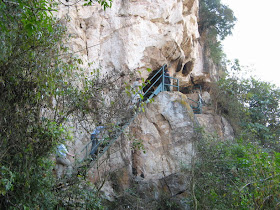Vieng Xai’s claim to fame is that it is the birthplace of Lao PDR (People’s Democratic Republic). Laos gained independence in 1949, this was followed by a civil war, and then the communist Pathet Lao came to power in 1975. Around this time, Vieng Xai got caught up in a secret war and became the site of an unprecedented but little known episode in world history.
In the early 1960’s the Pathet Lao moved their headquarters from Vientiane to Houa Phanh province. As the USA tried to halt what it saw as the expansion of communism after World War 2, Laos became caught up in this secret war. The US set out to destroy the Lao revolutionary movement whilst denying any military involvement in the country.
In an attempt to destroy the Pathet Lao’s new command centre at Vieng Xai, the US embarked on a devastating aerial bombing campaign that would last for nine years (1964-1973). More than two million tonnes of ordnance were dropped on Laos over this period – more bombs than were dropped on Europe during the Second World War. This total is equivalent to one planeload of bombs every 8 minutes for 9 years. However this fact is little known in world history!
To escape from this onslaught, around 23,000 people took to Vieng Xai’s natural caves and they constructed the ‘Hidden City’ for the leaders. In internal exile, the Pathet Lao continued to direct the resistance struggle from the city hidden in the limestone hills. They lived in the caves from 1964-1973. Today this network of caves is open to tourists, and as you go around, you can learn more about the history of Laos.
Several caves were selected as the family homes and offices of the leaders. Natural caves were enlarged, tunnels developed and internal ceilings inserted. Airtight rooms with air filtering equipment were constructed, to use in the event of a gas attack. Blast walls over 1.5 metres thick were built to shield cave entrances from rockets and guided missiles. Visitors to Vieng Xai today can visit the leaders’ caves, some of which still contain their personal possessions. There are about 6 major caves to visit.
Kaysone Phomvihanh’s Cave
Kaysone Phomvihanh’s toilet and wash place (above)
emergency room -
Kaysone Phomvihanh’s bedroom
Kaysone's office
tunnel
Kaysone meeting room
shrapnel marks
lunch outside the cave
Sankhid our guide
Nouhak 's car
Khamtay Siphandone Cave
entrance with defence walls
Theatre Cave
cave cricket
Khamtay Siphandone
Khamtay's bedroom
poinsetta
old relic
now a kids' playground
Hospital Cave
Souphanouvong's toilet, ensuite to the living room
kitchen
Souphanouvong’s living room with ensuite washroom and toilet
steel doors
Souphanouvong 's garden
Souphanouvong’s Cave with protected entrance
Phoumy Vongvicht was the Minister of Education and Politbureau. Water tank at the hospital cave.
 |
 |
| expedition van |
© Liz Price
No reproduction without permission

































































wow the great cave!
ReplyDeleteໂອ ພະເຈົ້າຍອດ ມັນຈັອດມາກ
ReplyDeleteCannot read this !
ReplyDeleteSabaidee
ReplyDeleteThese pics are very nice
Have you ever gone to Laos?
Laos is my country
sorry
Are you Lao?
Thanks for visit my Country
ReplyDeleteHow was is it?
I've been to Laos several times. I've been on caving expeditions, http://www.laoscaveproject.de/
ReplyDeleteWow...Very amazing Project
ReplyDeleteThanks for your kind